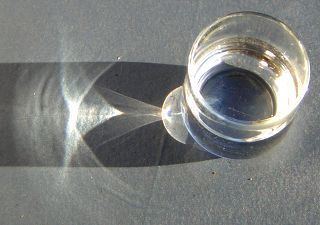 | ||
In optics, a caustic or caustic network is the envelope of light rays reflected or refracted by a curved surface or object, or the projection of that envelope of rays on another surface. The caustic is a curve or surface to which each of the light rays is tangent, defining a boundary of an envelope of rays as a curve of concentrated light. Therefore, in the adjacent image, the caustics can be the patches of light or their bright edges. These shapes often have cusp singularities.
Contents
Explanation
Concentration of light, especially sunlight, can burn. The word caustic, in fact, comes from the Greek καυστός, burnt, via the Latin causticus, burning. A common situation where caustics are visible is when light shines on a drinking glass. The glass casts a shadow, but also produces a curved region of bright light. In ideal circumstances (including perfectly parallel rays, as if from a point source at infinity), a nephroid-shaped patch of light can be produced. Rippling caustics are commonly formed when light shines through waves on a body of water.
Another familiar caustic is the rainbow. Scattering of light by raindrops causes different wavelengths of light to be refracted into arcs of differing radius, producing the bow.
Computer graphics
In computer graphics, most modern rendering systems support caustics. Some of them even support volumetric caustics. This is accomplished by raytracing the possible paths of a light beam, accounting for the refraction and reflection. Photon mapping is one implementation of this. Volumetric caustics can also be achieved by volumetric path tracing. Some computer graphic systems work by "forward ray tracing" wherein photons are modeled as coming from a light source and bouncing around the environment according to rules. Caustics are formed in the regions where sufficient photons strike a surface causing it to be brighter than the average area in the scene. “Backward ray tracing” works in the reverse manner beginning at the surface and determining if there is a direct path to the light source. Some examples of 3D ray-traced caustics can be found here.
The focus of most computer graphics systems is aesthetics rather than physical accuracy. This is especially true when it comes to real-time graphics in computer games where generic pre-calculated textures are mostly used instead of physically correct calculations.
Caustic engineering
Researchers have found that they can make use of caustics to create a desired image by shaping transparent material in a particular way. A surface of a panel of transparent material (e.g. acrylic glass) can be shaped such that the panel refracts light in a specific way to form the chosen image whenever the panel is held at a particular angle between a light source and a white wall.
